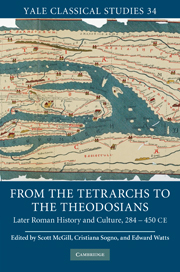Book contents
- Frontmatter
- Contents
- Acknowledgments
- Introduction
- PART I POLITICS, LAW, AND SOCIETY
- PART II BIOGRAPHY AND PANEGYRICS
- 6 Three generations of Christian philosophical biography
- 7 The education of Paulinus of Pella: learning in the late empire
- 8 Another man's miracles: recasting Aelius Donatus in Phocas's Life of Virgil
- 9 Gregory of Nazianzus's Life of Julian revisited (Or. 4 and 5): the art of governance by invective
- PART III FACES OF THEODOSIUS I
- References
- Index
8 - Another man's miracles: recasting Aelius Donatus in Phocas's Life of Virgil
from PART II - BIOGRAPHY AND PANEGYRICS
Published online by Cambridge University Press: 04 August 2010
- Frontmatter
- Contents
- Acknowledgments
- Introduction
- PART I POLITICS, LAW, AND SOCIETY
- PART II BIOGRAPHY AND PANEGYRICS
- 6 Three generations of Christian philosophical biography
- 7 The education of Paulinus of Pella: learning in the late empire
- 8 Another man's miracles: recasting Aelius Donatus in Phocas's Life of Virgil
- 9 Gregory of Nazianzus's Life of Julian revisited (Or. 4 and 5): the art of governance by invective
- PART III FACES OF THEODOSIUS I
- References
- Index
Summary
his fave dictis! retegenda vita est
vatis Etrusci modo, qui perenne
Romulae voci decus adrogavit
carmine sacro.
Look kindly on these words!
Now the life of the Etruscan bard must be made known,
who claimed eternal glory for the Latin language
through his sacred poetry.
So the biographer Phocas ends his invocation to the muse Clio that precedes his hexameter Life of Virgil. A grammarian and teacher at Rome, Phocas likely dates to the late fourth or fifth century. His Vita, with a twenty-four-line preface in sapphics, a concluding lacuna, and textual problems in lines 75–83, is the only example we have of an ancient Virgilian biography written in verse.
Scholarship on Phocas has consistently traced his Vita back to earthlier sources than Clio. These are the Virgilian biographies of Suetonius and the fourth-century CE Aelius Donatus, who, the evidence is strong, essentially reproduced the now lost Suetonian text. (The abbreviation VSD conventionally designates Donatus's work, with its presumed origins in Suetonius.) While some identify Suetonius as Phocas's model or maintain an agnostic stance with regard to which of his precursors Phocas used, the majority position is that he relied upon his fellow late-antique biographer Donatus. Lending credence to this viewpoint is Phocas's treatment of how Virgil got caught up in the land confiscations that followed the Battle of Philippi (92–113).
- Type
- Chapter
- Information
- From the Tetrarchs to the TheodosiansLater Roman History and Culture, 284–450 CE, pp. 153 - 170Publisher: Cambridge University PressPrint publication year: 2010
- 1
- Cited by



